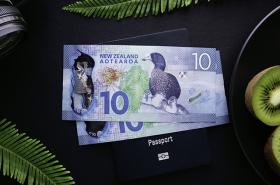Quick Contact

1st March 2019
The Kiwi dollar has had an interesting week, reaching a high on Tuesday before falling slightly to where it is now. As it stands, one NZD will buy you:
0.6724 US dollars
0.5858 euros
0.5009 Great British pound
0.8744 Canadian dollars
0.9441 Aussie Dollars
Don’t forget to grab your currency from our Frenzy Sale! You only have until the end of Friday to snag huge bonuses on major currencies*.
Frenzy aside, a few key global events have impacted the value of the New Zealand dollar this week including better than expected US economic growth figures, positive progress in the US/China trade war and poor economic data out of China.
The USA is us-slaying economic growth
On Thursday, the US GDP growth rate for Q4 2018 was released. A rate of 2.6% exceeded market growth expectations. As a result, the the value of the USD was bolstered. This wasn’t great for the NZ dollar or Kiwi tourists.
Despite this increase, there are no major changes in the US Federal Reserve Bank’s ‘patient’ stance on monetary policy. The current global economic climate, and its effect on the US economy, is encouraging the Fed to keep interest rates on hold for the time being. This is good news for Kiwi travellers, as an increase in US interest rates would put further downward pressure on the value of the NZD as investors seek a higher return from the USD. Less demand for the NZD = decrease in value.
A Rachel & Ross affair: the on-again-off-again saga with China and the US
Negotiations between the US and Chinese delegates continued this week, as they seek to agree on a trade deal that meets the needs of both countries.
These negotiations can be likened to that ‘on-again-off-again’ relationship that your friend always seems to update you on. One minute things are dandy, the next, neither party is speaking to each other, despite both desperately wanting to be together. It’s complicated.
The good news is that White House economic advisor Larry Kudlow said both parties had made 'terrific’ progress on negotiating a deal. It seems both countries are on the verge of a ‘historic’ trade deal. While it’s safe to say both countries are safely in the on-again phase, the positive news did not have much of an effect in cushioning or reversing the NZD’s decrease in value. Perhaps this is because markets had already priced in, or adjusted their predictions to account for this positive news. Or perhaps it’s a case of the boy who cried wolf, with markets expecting that we could very swiftly move into the all familiar off-again territory.
Only time will tell how this pans out. It is in New Zealand's best interest for the trade deal to go as smoothly as possible, as any tariffs increase on Chinese exports into the US will have negative flow on effects on the NZ economy and the NZD.
The brakes are slamming on China’s economy
A perfect example of these flow on effects is the fact that the NZD suffered as a result of poor economic data out of China. On Thursday, China released their official manufacturing Purchasing Managers Index (PMI) for February. The index signalled the third consecutive month of contraction for Chinese manufacturing. This raises fresh concerns about economic slowdown in China.
Trump and Kim Jong Un cancelled lunch
This week saw President Trump and Korean Leader Kim Jong Un meet in Vietnam. Their bromance appeared to be flourishing until yesterday, when their summit was abruptly cancelled. Reports show that there wasn’t any noteworthy progress on nuclear disarmament, which is kind of disappointing because nuclear weapons scare the bejesus out of me / the rest of the planet.
Fingers crossed the leaders can reignite both the negotiations and their bromance soon.
In a shock turn of events, nothing has happened with Brexit.
That’s a lie… a few things happened this week. By ‘things’ we mean ‘announcements were made but Britain still has no idea what is going on.’ Long story short:
- There was meant to be a ‘meaningful vote’ on Wednesday, but Theresa May delayed that until March 12, 2019.
- Following this, the Labour party announced that if their alternative Brexit plan was rejected, they would support a second referendum.
- This Labour announcement triggered Theresa May to make her own announcement on Tuesday, being that should her deal fail on March 12, British MPs will have the opportunity to vote in favour of a no deal on March 13.
- If both of these votes fail (let’s face it, there is a high probability that they will), on March 14 there will be another vote to request a delay to the March 29, 2019 Brexit deadline.
So, in reality, it’s a case of ‘same (insert word that I can’t publish), different day’ on the Brexit front.
If you are planning a trip to the United Kingdom in the next few months, we recommend educating yourself on how Brexit could affect your travels. Sign up for rate alerts while you’re at it, and that way if the NZD reaches your preferred level against the GBP (or any other currency), we can let you know.
Debbie downer domestic data
Today, we have seen the release of New Zealand consumer confidence for February 2019??, as well as the terms of trade data for Q4.
Consumer confidence fell by 0.9 points to 120.8 in February. This decrease culminated as a result of the following:
- Consumer perception of current financial situation lifted by 2 points, with 14% feeling financially better off than a year ago.
- Consumer perception of their confidence in their financial situation in a year’s time decreased by 2 points.
- Consumer perception regarding next year’s overall economic outlook fell by 3 points.
- Consumer perception of the five-year economic outlook fell by 5 points.
So whilst there was a lift in how consumers are feeling about their current finances, they’re losing optimism about the future. You and me both, New Zealand.
In more disappointing news, the NZ Terms of Trade are also down in Q4. A country’s terms of trade measures the purchasing power of their exports abroad.
Export prices fell by 1.7 percent, while import prices increased by 1.4%. As a result of this, overall terms of trade fell 3%. This is most likely due to lower prices on the country’s key export, dairy.
Considering markets expected a 1% decrease, the 3% figure will put downward pressure on the value of the NZD.
If you are travelling soon, we recommend adding Rate Guard to your purchase in store. It’s free and if the rate improves within 14 days of purchase we will refund you the difference^.
Definitions for those of us playing at home:
Purchasing Managers Index (PMI)
An index that summarised the results from a monthly survey completed by enterprise purchasing managers about aspects such as purchasing, production and logistics. The PMI is a common tool used to monitor macroeconomic trends, therefore influencing exchange rate forecasts.
This blog is provided for information only and does not take into consideration your objectives, financial situation or needs. You should consider whether the information and suggestions contained in any blog entry are appropriate for you, having regard to your own objectives, financial situation and needs. While we take reasonable care in providing the blog, we give no warranties or representations that it is complete or accurate, or is appropriate for you. We are not liable for any loss caused, whether due to negligence or otherwise, arising from use of, or reliance on, the information and/or suggestions contained in this blog.
All rates are quoted from the Travel Money NZ website, and are valid as of 1 March 2019
*Click Frenzy bonus applies to CNY, CAD, EUR, GBP, HKD, IDR, JPY, NZD, SGD, THB, USD and VND. See travelmoneyoz.com/offers for more information
*Terms and conditions apply to Rate Guard. See http://www.travelmoney.co.nz/rate-guard for more information.












